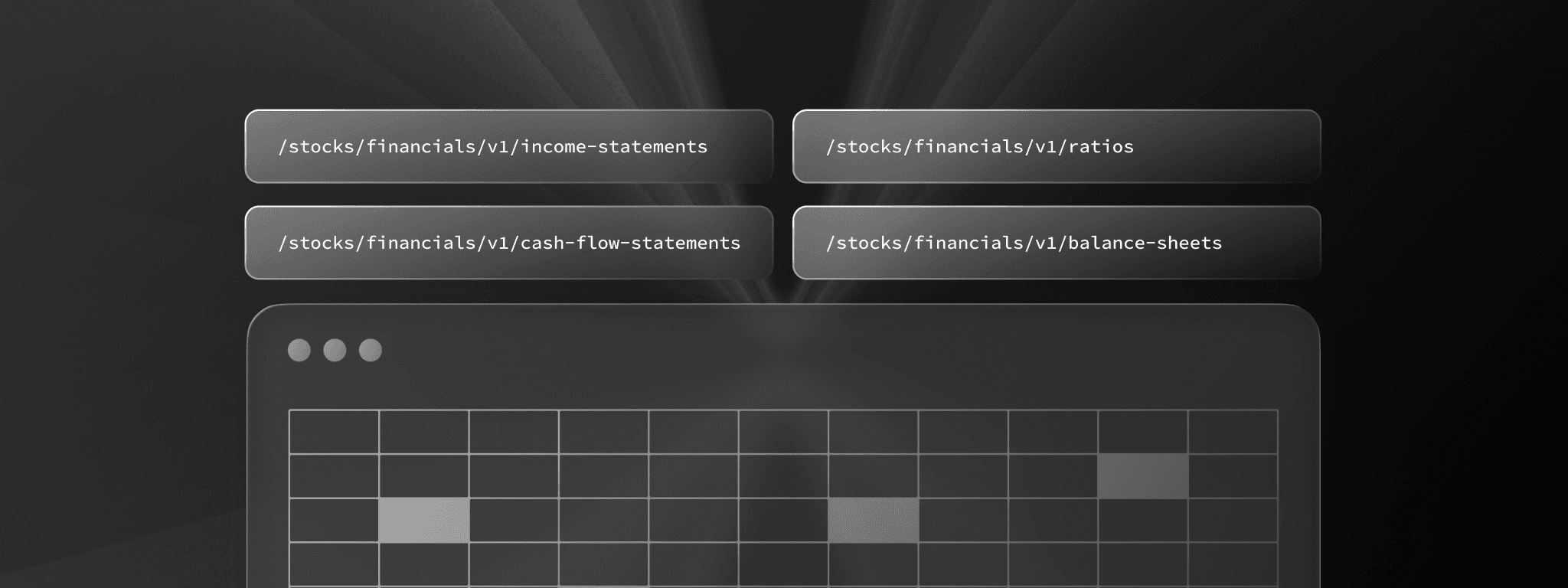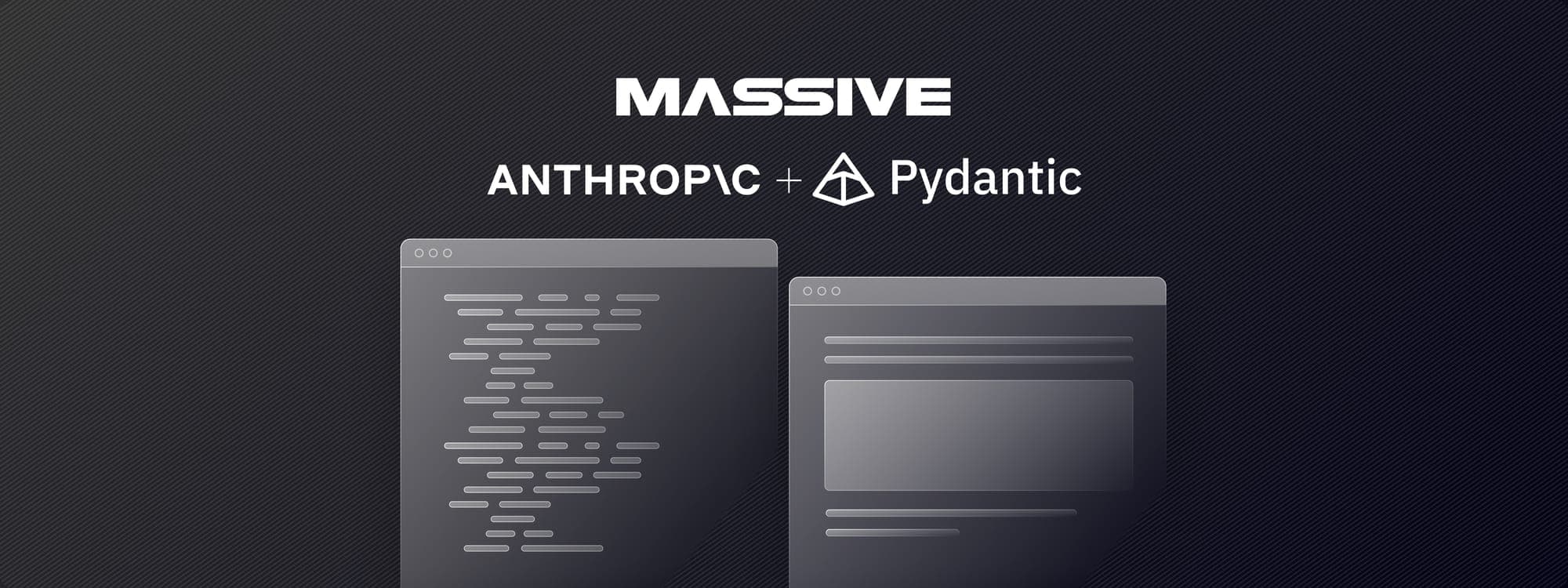
Polygon.io is Now Massive
Polygon.io is now Massive.com. The rebrand reflects our focus on scale, reliability, and continued innovation. Your APIs, accounts, and integrations continue to work without interruption.
editor

Introducing
Oct 22, 2025
For years, the most painful part of fundamentals has been stitching filings, prices, and share counts into something you can actually screen or model on. Our new Financials endpoints deliver normalized Balance Sheets, Cash Flow Statements, and Income Statements across quarterly, annual, and TTM frequencies. Additionally, the new Ratios endpoint combines those statements with point-in-time price and shares to compute valuation, profitability, liquidity, leverage, and EV multiples for the latest trading day, all in one call.
If you’re migrating from the old “experimental financials” API: it’s deprecated in favor of these v1 endpoints. Start here going forward. You must be on our stocks advanced plan to
Coverage & cadence: Financial statements go back well over a decade with quarterly, annual, and TTM; ratios are updated daily for active tickers.
What it does: Returns point-in-time positions (what the company has and owes).
Why it’s useful: Evaluate risk, compute Debt/Equity, Current/Quick/Cash ratios, or track working-capital cycles over time.
Sample use cases:
Python sample:
from massive import RESTClient import json client = RESTClient(api_key="KEY") # Get the raw JSON response response = client.list_financials_balance_sheets( tickers="AAPL", fiscal_year=2024, fiscal_quarter="4", timeframe="quarterly", raw=True ) # Decode and print the JSON json_data = json.loads(response.data.decode('utf-8')) print(json.dumps(json_data, indent=2))
Sample response:
{ "status": "OK", "request_id": "REQUEST_ID", "results": [ { "tickers": [ "AAPL" ], "cik": "0000320193", "period_end": "2024-09-28", "filing_date": "2025-08-01", "fiscal_quarter": 4, "fiscal_year": 2024, "timeframe": "quarterly", "cash_and_equivalents": 29943000000, "short_term_investments": 35228000000, "receivables": 66243000000, "inventories": 7286000000, "other_current_assets": 14287000000, "total_current_assets": 152987000000, "property_plant_equipment_net": 45680000000, "other_assets": 166313000000, "total_assets": 364980000000, "accounts_payable": 68960000000, "deferred_revenue_current": 8249000000, "debt_current": 20879000000, "accrued_and_other_current_liabilities": 78304000000, "total_current_liabilities": 176392000000, "long_term_debt_and_capital_lease_obligations": 85750000000, "other_noncurrent_liabilities": 45888000000, "total_liabilities": 308030000000, "common_stock": 83276000000, "accumulated_other_comprehensive_income": -7172000000, "retained_earnings_deficit": -19154000000, "other_equity": 0, "total_equity_attributable_to_parent": 56950000000, "total_equity": 56950000000, "total_liabilities_and_equity": 364980000000 } ] }
What it does: Returns the movement of operating, investing, and financing cash flows in and out of a company.
Why it’s useful: Build free cash flow (FCF) models and capex discipline screens; separate core cash generation from buybacks/issuance.
Sample use cases:
Python Sample:
from massive import RESTClient import json client = RESTClient(api_key="KEY") # Get the raw JSON response response = client.list_financials_cash_flow_statements( tickers="AAPL", fiscal_year=2024, fiscal_quarter="4", timeframe="quarterly", raw=True ) # Decode and print the JSON json_data = json.loads(response.data.decode('utf-8')) print(json.dumps(json_data, indent=2))
Sample Response:
{ "status": "OK", "request_id": "REQUEST_ID", "results": [ { "tickers": [ "AAPL" ], "cik": "0000320193", "period_end": "2024-09-28", "filing_date": "2025-08-01", "fiscal_quarter": 4, "fiscal_year": 2024, "timeframe": "quarterly", "net_income": 14736000000.0, "depreciation_depletion_and_amortization": 2911000000.0, "other_operating_activities": 2556000000.0, "change_in_other_operating_assets_and_liabilities_net": 6608000000.0, "cash_from_operating_activities_continuing_operations": 26811000000.0, "net_cash_from_operating_activities": 26811000000.0, "purchase_of_property_plant_and_equipment": -2908000000.0, "other_investing_activities": 4353000000.0, "net_cash_from_investing_activities_continuing_operations": 1445000000.0, "net_cash_from_investing_activities": 1445000000.0, "short_term_debt_issuances_repayments": 6945000000.0, "long_term_debt_issuances_repayments": -2558000000.0, "dividends": -3804000000.0, "other_financing_activities": -25531000000.0, "net_cash_from_financing_activities_continuing_operations": -24948000000.0, "net_cash_from_financing_activities": -24948000000.0, "change_in_cash_and_equivalents": 3308000000.0 } ] }
What it does: Also known as the profit and loss (P&L), it returns revenue, expenses, and net income across quarterly, annual, and TTM periods of time.
Why it’s useful: One of the most important documents for assessing a company’s financial performance. Track growth vs. margin expansion, backtest rule-based earnings screens.
Sample use cases:
Python sample:
from massive import RESTClient import json client = RESTClient(api_key="KEY") # Get the raw JSON response response = client.list_financials_income_statements( tickers="AAPL", fiscal_year=2024, fiscal_quarter="4", timeframe="quarterly", raw=True ) # Decode and print the JSON json_data = json.loads(response.data.decode('utf-8')) print(json.dumps(json_data, indent=2))
Sample response:
{ "status": "OK", "request_id": "REQUEST_ID", "results": [ { "tickers": [ "AAPL" ], "cik": "0000320193", "period_end": "2024-09-28", "filing_date": "2025-08-01", "fiscal_quarter": 4, "fiscal_year": 2024, "timeframe": "quarterly", "revenue": 94930000000.0, "cost_of_revenue": 51051000000.0, "gross_profit": 43879000000.0, "selling_general_administrative": 6523000000.0, "research_development": 7765000000.0, "other_operating_expenses": 0.0, "total_operating_expenses": 14288000000.0, "operating_income": 29591000000.0, "other_income_expense": 19000000.0, "total_other_income_expense": 19000000.0, "income_before_income_taxes": 29610000000.0, "income_taxes": 14874000000.0, "consolidated_net_income_loss": 14736000000.0, "net_income_loss_attributable_common_shareholders": 14736000000.0, "basic_earnings_per_share": 0.98, "diluted_earnings_per_share": 0.97, "basic_shares_outstanding": 15343783000.0, "diluted_shares_outstanding": 15408095000.0, "ebitda": 32502000000.0 } ] }
What it does: Returns daily-refreshed ratios computed from TTM income & cash flow, latest quarter balance sheet, and the latest daily price & shares.
Why it’s useful: Easily get critical metrics, including P/E, P/S, P/B, EV/EBITDA, ROE/ROA, liquidity, D/E, EPS, EV, FCF, Market Cap, and more.
Sample use cases:
Python sample:
from massive import RESTClient import json client = RESTClient(api_key="KEY") # Get the raw JSON response response = client.list_financials_ratios( ticker="AAPL", raw=True ) # Decode and print the JSON json_data = json.loads(response.data.decode('utf-8')) print(json.dumps(json_data, indent=2))
Sample response:
{ "status": "OK", "request_id": "REQUEST_ID", "results": [ { "ticker": "AAPL", "cik": "0000320193", "date": "2025-10-20", "price": 262.24, "average_volume": 54815761.0, "market_cap": 3891743873600.0, "earnings_per_share": 6.69, "price_to_earnings": 39.2, "price_to_book": 59.12, "price_to_sales": 9.52, "price_to_cash_flow": 35.85, "price_to_free_cash_flow": 40.46, "dividend_yield": 0.0039, "return_on_assets": 0.2995, "return_on_equity": 1.5081, "debt_to_equity": 1.54, "current": 0.87, "quick": 0.83, "cash": 0.26, "ev_to_sales": 9.68, "ev_to_ebitda": 27.93, "enterprise_value": 3957172873600.0, "free_cash_flow": 96184000000.0 } ] }
Ratios are daily snapshots built from time-appropriate inputs (TTM, most-recent quarter, latest daily price/shares). Some ratios intentionally omit values (e.g., P/E when EPS ≤ 0) or return null when the denominator is zero. That’s by design to prevent misleading outputs. If a field is missing, check the omission criteria first.

Alex Novotny
alexnovotny
See what's happening at Massive

Polygon.io is now Massive.com. The rebrand reflects our focus on scale, reliability, and continued innovation. Your APIs, accounts, and integrations continue to work without interruption.
editor

Effective Nov 3, 2025, bid_size/ask_size will be reported in shares (not round lots) across Stocks Quotes REST API, WebSocket, and Flat Files, per SEC MDI rules. The rule is forward-looking and we’ll also backfill history for consistency. Most users need no changes.
editor

Learn how to use Massive's MCP server inside of a Pydantic AI agentic workflow, alongside Anthropic's Claude 4 and the Rich Python library.

alexnovotny